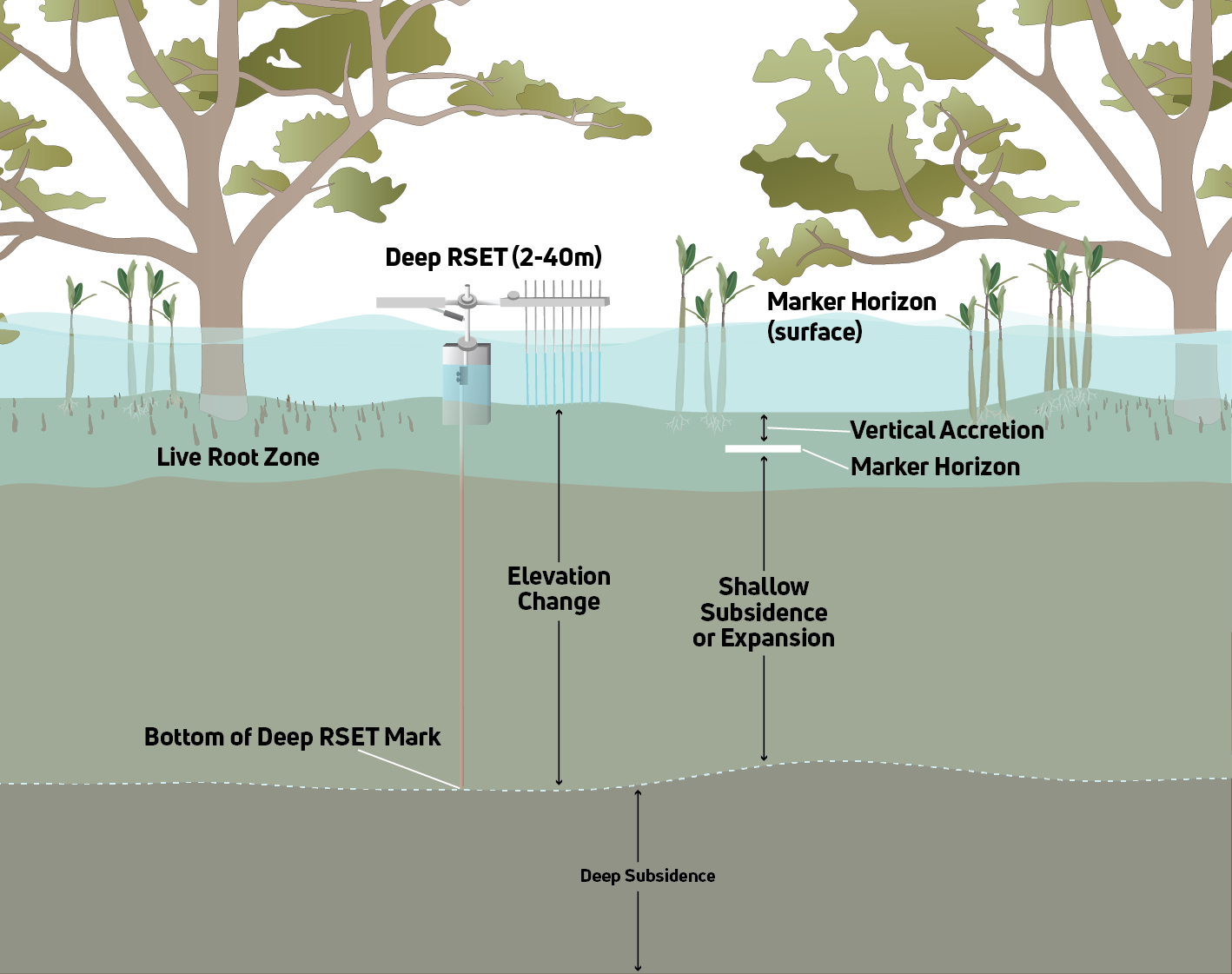OzSET
The OzSET researcher community, supported by TERN, operates a national network of over 300 Surface Elevation Tables (SETs) which monitor changes in tidal wetland elevation.
By doing this, researchers can track the health of tidal ecosystems and coastlines in the face of climate change and rising sea levels.
Can tidal wetlands keep up with sea-level rise around Australia?
Mangroves, salt marsh and supratidal forests are important tidal wetland ecosystems contributing to a range of ecosystem services. However, these coastal wetlands are highly sensitive to changes in sea-level, given their low coastal elevation and frequent tidal inundation.
Maintaining elevation despite sea level rise is crucial for tidal wetlands to persist.
Mangroves and saltmarsh vertically adjust to sea level rise via sediment accretion and below ground soil volume additions (e.g., root growth).
Tidal wetlands maintaining elevation relative to sea level rise may also offer some natural coastal protection from some of the impacts of rising sea levels. For example, having healthy vegetated coastal habitats mitigates against impacts such as saltwater incursion and erosion of adjacent habitats, private and public assets and cultural heritage sites.

Surface Elevation Tables (SETs)
To better understand tidal wetland response and vulnerabilities to sea-level rise, Australian and international researchers have been monitoring vertical elevation change for many years using Surface Elevation Tables (including the modern Rod Surface Elevation Table design), a method developed by the USGS.
SETs precisely measure tidal wetland surface height over time and can track the changes in wetland elevation that occur through plant root growth below ground and sediment deposition above ground.
Monitoring elevation of these important wetlands through time allows for comparisons to the rate of change with sea level rise and other environmental impacts in different tidal wetland regions.

Above: Measuring a rod surface elevation table (RSET) in Darwin Harbour (Image: Madeline Goddard).
The OzSET network
Australia has a network of over 300 Surface Elevation Tables (SETs) located around its coasts which are operated by the Oz-SET researcher community.
TERN, as Australia’s Ecosystem Observatory, is supporting the Oz-SET researcher network, particularly with ensuring standardised protocols and a central data repository available through TERN’s Data Discovery Portal.
Project timeline
The OzSET project with TERN runs for 3 years starting in 2024.
November 2024
Scope & launch project
Inform / consult user community
December 2024
Create community of practice
Establish current user group
2024 - 2027
National SET monitoring
National monitoring using SET methodology
Synthesis of national network of rod surface elevation tables (RSET) data and representation of data at a national scale
Synthesis report: July 2026
2025 - 2027
Strong Governance, evaluation & planning
Annual (March) and mid-year (September) activity reports
December 2025
OzSET data & protocols
Up-to-date SET protocols and Standard Operating Procedures (SOP) document published online
July 2026
Strategic Report
Future monitoring budget & strategy
July 2026
Synthesis Report
July 2027
Data available
OzSET data recognised as National Research Infrastructure (NRI)
OzSET data and metadata available through TERN Discovery Portal
In the above webinar excerpt, Madeline Goddard discusses her research as part of the OzSET community (15 mins).
Learn more
Learn more about tidal wetland monitoring at the following links:
Glossary
MH: Marker Horizon, a layer of contrast, usually feldspar, added to delineate new sediment accretion from the existing surface.
Monitoring (R)SETs: The process of measuring vertical surface elevation using either RSET or SET instruments.
RSET: Rod Surface Elevation Table, the modern version of a SET, consisting of stainless steel rods forming a bench mark (Cahoon et al. 2002).
SET: Surface Elevation Table, the original design to measure surface elevation (Cahoon et al. 1995).
SLR: Sea-level rise.
Tidal wetland: Coastal vegetated ecosystems that are tidally influenced such as mangroves and saltmarsh.
References
Cahoon, D. R., Lynch, J. C., Perez, B. C., Segura, B., Holland, R. D., Stelly, C., … & Hensel, P. (2002). High-precision measurements of wetland sediment elevation: II. The rod surface elevation table. Journal of sedimentary research, 72(5), 734-739
Cahoon, D. R., Reed, D. J., & Day Jr, J. W. (1995). Estimating shallow subsidence in microtidal salt marshes of the southeastern United States: Kaye and Barghoorn revisited. Marine geology, 128(1-2), 1-9
Lynch, J. C., P. Hensel, and D. R. Cahoon. 2015. The surface elevation table and marker horizon technique: A protocol for monitoring wetland elevation dynamics. Natural Resource Report NPS/NCBN/NRR—2015/1078. National Park Service, Fort Collins, Colorado
Saintilan, N., Sun, Y., Lovelock, C. E., Rogers, K., Goddard, M., Hutley, L. B., … & Jones, A. (2023). Vertical accretion trends in Australian tidal wetlands. Estuaries and Coasts, 1-14
Contacts
The TERN Oz-SET project coordinators are Madeline Goddard and Vicki Bennion, contactable at ozset.tern@uq.edu.au.

